七年级英语下册-Unit-6-I’m-watching-TV(Section-A1-1a-2d)-教案-(新版)人教新目标版
- 格式:doc
- 大小:133.50 KB
- 文档页数:4
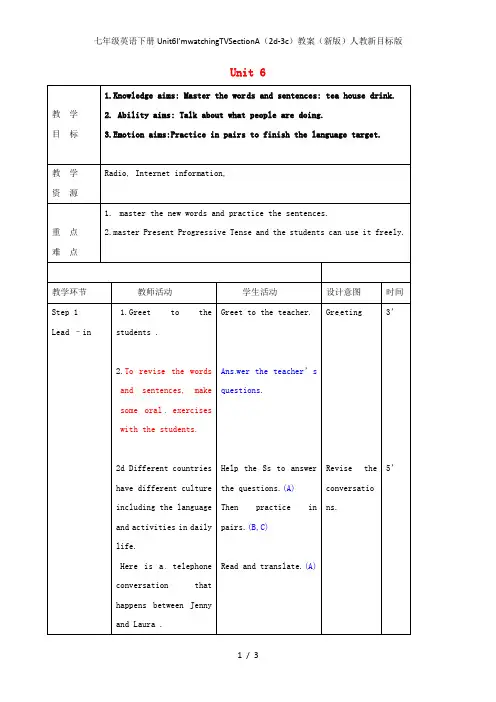
Unit 6教学目标1.Knowledge aims: Master the words and sentences: tea house drink.2. Ability aims: Talk about what people are doing.3.Emotion aims:Practice in pairs to finish the language target.教学资源Radio, Internet information,重点难点1.master the new words and practice the sentences.2.master Present Progressive Tense and the students can use it freely.教学环节教师活动学生活动设计意图时间Step 1 Lead –in1.Greet to thestudents .2.To revise the wordsand sentences, makesome oral exerciseswith the students.2d Different countrieshave different cultureincluding the languageand activities in dailylife.Here is a telephoneconversation thathappens between Jennyand Laura .Greet to the teacher.Ans wer the teacher’squestions.Help the Ss to answerthe questions.(A)Then practice inpairs.(B,C)Read and translate.(A)GreetingRevise theconversations.3’5’Step 2 Conversa tionStep 3. Grammar ForceStep 4. Practice Step5A gameStep6 consolidatio Find the difference.The teacher tries tomake Ss find more andadd more differentcultures in thetelephone conversationGrammar force :1.Show Grammar focusto the students,Askthem to go over thegramm ar bythemselves .2 .Try to summarize therules of it.The teachershows the rules of thePresent ProgressiveTense on the screen.give some othersentences .Practice (3a,3b ) Showa picture of a boy whois playing soccer.askswhat does he do onSundays? Show anotherpicture of a boy who iswatching TV and askswhat is he doing?Read and translate theco ntent in the form.(A)Then practice inpairs.(B,C)Write down thesentences .(A)The Ss can say manyanswers.(B)Write the grammarfocus.(C)Ask some pairs to playthe game like this.Practing thetargetlanguage.Master thegrammarfocus.10’10’nStep 7 Sum upStep 8 Homework 3c. Let ‘s play agame.One student comesto the front and doesan action. The otherstudent guesses what heis doing .who can try?The teacher will askthe students to do someactivities to m asterthe languages pointsLet the Ss talk aboutwhat they have learned.Finish the exercises inthe exercise book.Homework :A,B,C.Ss finish all theexercises .The Ss make the game topractice the conversations.The Ss make a summaryabout the points.Practicingtargetlanguage.SummaryRevision10’5’2’板书设计Unit 6 I’m watching TV.Words and sentences:House drink teaWhat are you doing ?He is +v.ing教学后记Play a game use the words, this way can help the students remember the words.。

Unit 6 I’m watching TV.一、Teaching Goal:In this unit students learn to talk about what people are doing. Teach students how to cooperate and be good at watching something and love our lives.二、Teaching difficulties1. The vocabulary and the sentence structures.2. Learn the grammar: Present progressive tense.3. Oral practice using the target language.三、Teaching MethodsListening and practicing methods, pair work, Task-Based Learning method.四、Teaching AidsA tape recorder, some pictures and cards.五、Teaching Time: 5 periodsPeriod 1 (Section A:1a—2b)Teaching ProceduresStep 1.Revision1. Greeting s.2. Revise the words and expressions in Unit 4.Step 2.Presatation: Lead in1. Do “Ask and answer” practice with the Ss.2. The teacher asks the students to give more verbs phrases and write them down on the blackboard.(show many pictures to help theSs.)Teach the new words and expressions.3. Teach the Present Progressive.1)Introduction: Talk about the title of this unit. Show some pictures to introduce the Present Progressive tense.T: What’s she/he doing?Ss: She/He is v-ing (Help the Ss to answer the questions and showthe sentences)2) Let the Ss to say what the Present Progressive is.(现在进行时表示现在正在进行或发生的动作, 它的表现形式为:Be Verbs + V-ing ….)3). Tell the differenceWrite down the V-ing forms by another lines of go, watch, do, play and eat . Ask the Ss to have a look and find the difference between them. For example: go and going, watch and watching, do and doing, etc. Then ask the Ss to read them again and do more exercises.Step3.Activity 1a:Match1. Help the Ss talk about the pictures. The Ss read these V-ingwordsafter the tea cher. Match the words and the activities. Check the answers.2. Help the Ss do “Ask and answer” practice i n pairs.3. Ask some Ss to do actions and let the class guess whathe/she is doing.Step4.Activity 1b & 1c: Listening and pair work.1. Play the recording for the Ss to listen. Play again. Ss listen and write the number of the activity each person is doing. Check the answers.2. Pairwork: Ask the Ss to do “Ask and answer” practice about the picture in pairs. Some pairs present their dialogues to the class. Step 5.Activity 2a & 2b: Listening and Practice1.Activity 2a:Talk about the picture in 2b.Ask the Ss to read the questions in 2a. Then listen to the tape and and write the answers. Check the answers.2.Activity 2b:Pl ay the recording again. Help the Ss put these questions and answers in order to make a conversation. Go through the answers with the Ss.Step 6 Pairwork: Activity 2c1.Talk about the pictures in 2c. Ask Ss to read the sampleconversation. Let Ss look at the first group of pictures, and ask them to guess what the people are doing.2. Then imitate the sample conversation, work in pairs. Some pairs present their dialogues to the class.3. A guessing game: Guess the activities according to the Ss’ actions.Step 7 Grammar focusGo through the sentences with the Ss. Deal with some languagepoints.Step 8 Homework:1.Copy the new words and recite.2.Make up their own dialogues.。
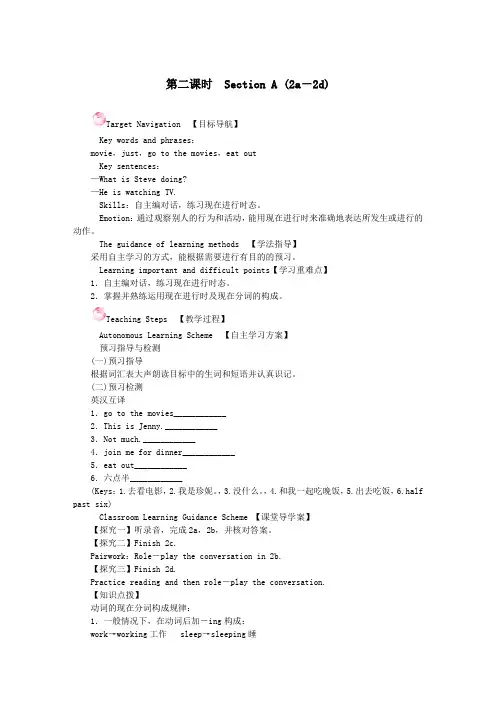
第二课时Section A (2a-2d)Target Navigation 【目标导航】Key words and phrases:movie,just,go to the movies,eat outKey sentences:—What is Steve doing?—He is watching TV.Skills:自主编对话,练习现在进行时态。
Emotion:通过观察别人的行为和活动,能用现在进行时来准确地表达所发生或进行的动作。
The guidance of learning methods 【学法指导】采用自主学习的方式,能根据需要进行有目的的预习。
Learning important and difficult points【学习重难点】1.自主编对话,练习现在进行时态。
2.掌握并熟练运用现在进行时及现在分词的构成。
Teaching Steps 【教学过程】Autonomous Learning Scheme 【自主学习方案】预习指导与检测(一)预习指导根据词汇表大声朗读目标中的生词和短语并认真识记。
(二)预习检测英汉互译1.go to the movies____________2.This is Jenny.____________3.Not much.____________4.join me for dinner____________5.eat out____________6.六点半____________(Keys:1.去看电影,2.我是珍妮。
,3.没什么。
,4.和我一起吃晚饭,5.出去吃饭,6.half past six)Classroom Learning Guidance Scheme 【课堂导学案】【探究一】听录音,完成2a,2b,并核对答案。
【探究二】Finish 2c.Pairwork:Role-play the conversation in 2b.【探究三】Finish 2d.Practice reading and then role-play the conversation.【知识点拨】动词的现在分词构成规律:1.一般情况下,在动词后加-ing构成:work→working工作sleep→sleeping睡wait→waiting等待study→studying学习read→reading读talk→talking谈话2.以不发音的-e结尾动词(以辅音字母+e结尾),去掉e后再加-ing:smile→smiling微笑move→moving搬动write→writing写take→taking拿use→using使用exercise→exercising锻炼但是,若是以发音的e结尾,则不能去e:see→seeing看见agree→agreeing同意3.以重读闭音节结尾且末尾只一个辅音字母的动词,要双写末尾的辅音字母再加-ing:sit→sittingplan→planning计划prefer→preferring宁愿4.以字母ie结尾的动词,通常将ie改为y,再加-ing:die→dyinglie→lying躺Classroom Evaluation Scheme 【课堂评价案】详见当堂训练部分(即学生用书同步练习题)。
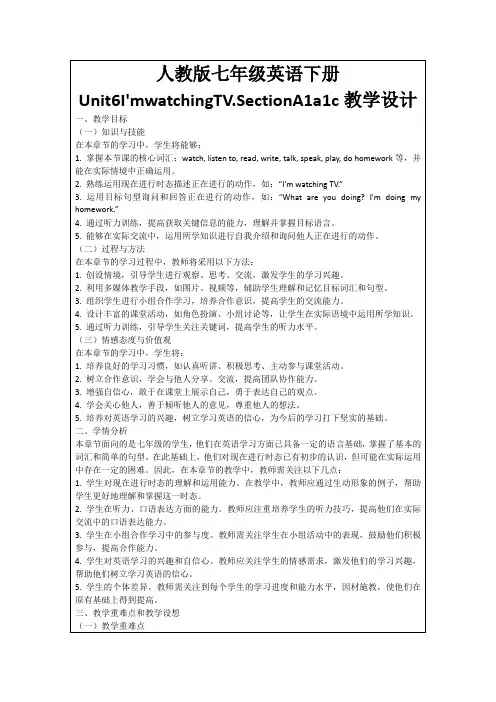
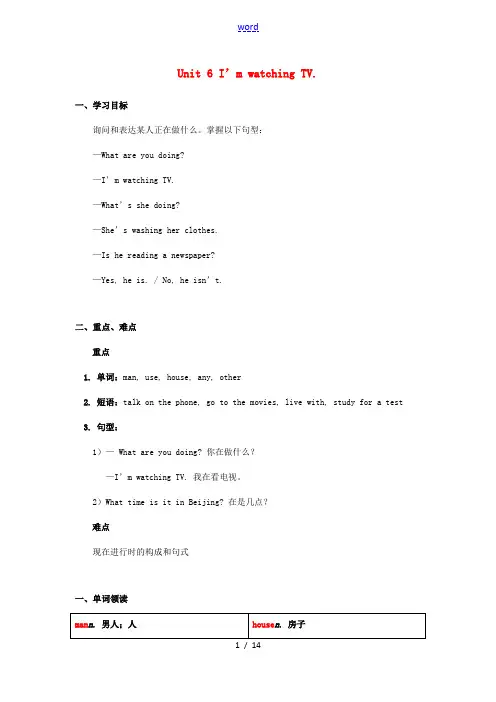
Unit 6 I’m watching TV.一、学习目标询问和表达某人正在做什么。
掌握以下句型:—What are you doing?—I’m watching TV.—What’s she doing?—She’s washing her clothes.—Is he reading a newspaper?—Yes, he is. / No, he isn’t.二、重点、难点重点1. 单词:man, use, house, any, other2. 短语:talk on the phone, go to the movies, live with, study for a test3. 句型:1)— What are you doing? 你在做什么?—I’m watching TV. 我在看电视。
2)What time is it in Beijing? 在是几点?难点现在进行时的构成和句式一、单词领读use v.使用;运用other adj. 另外的;其他的pron.另外的人(或物)any adj.任何的;任一的pron.任何;任一二、重点单词【单词学习】☆☆1. use v.使用;运用【用法】及物动词。
【例句】—Can I use your bike? 我可以用一下你的自行车吗?—Sure. 当然可以了。
【拓展】(1)use n.用法;使用;用途(2)useful adj.有用的;有益的(3)useless adj.无用的【例句】He makes good use of his time. 他充分利用他的时间。
English is useful to you. 英语对你来说有用。
Why do you think it’s useless? 你为什么认为它没用呢?【考题】Can you help me ______ the puter? I think it’s very _______.A. use; usefulB. to use; uselessC. useful; useD. use; useless答案:A思路分析:help sb. (to) do sth.,故C项错误;根据前句“你能帮助我使用电脑吗?”可知“我认为它是很有用的”,故用useful。
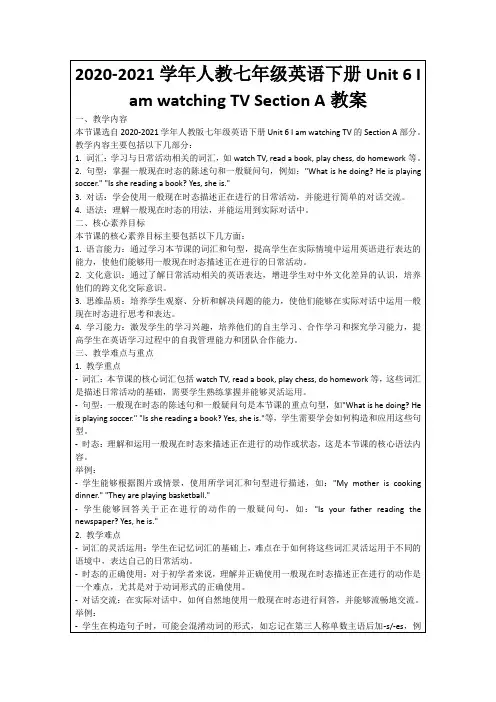
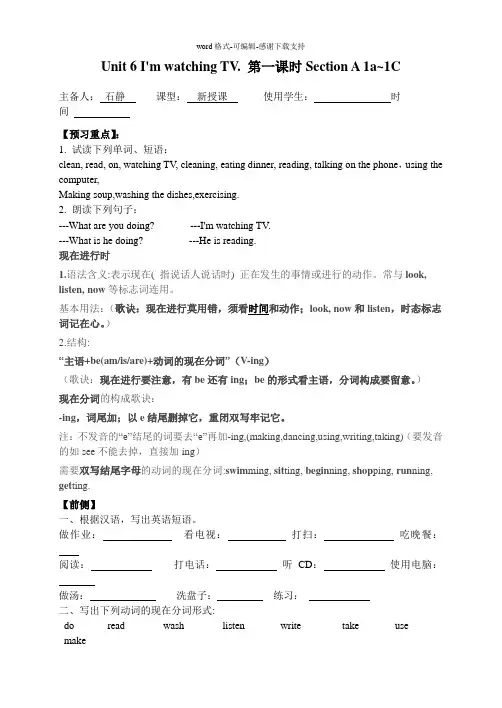
Unit 6 I'm watching TV. 第一课时Section A 1a~1C主备人:石静课型:新授课使用学生:时间【预习重点】:1. 试读下列单词、短语:clean, read, on, watching TV, cleaning, eating dinner, reading, talking on the phone,using the computer,Making soup,washing the dishes,exercising.2. 朗读下列句子:---What are you doing? ---I'm watching TV.---What is he doing? ---He is reading.现在进行时1.语法含义:表示现在( 指说话人说话时) 正在发生的事情或进行的动作。
常与look, listen, now等标志词连用。
基本用法:(歌诀:现在进行莫用错,须看时间和动作;look, now和listen,时态标志词记在心。
)2.结构:“主语+be(am/is/are)+动词的现在分词”(V-ing)(歌诀:现在进行要注意,有be还有ing;be的形式看主语,分词构成要留意。
)现在分词的构成歌诀:-ing,词尾加;以e结尾删掉它,重闭双写牢记它。
注:不发音的“e”结尾的词要去“e”再加-ing,(making,dancing,using,writing,taking)(要发音的如see不能去掉,直接加ing)需要双写结尾字母的动词的现在分词:swim ming, sit ting, begin ning, shop ping, run ning, get ting.【前侧】一、根据汉语,写出英语短语。
做作业:看电视:打扫:吃晚餐:阅读:打电话:听CD:使用电脑:做汤:洗盘子:练习:二、写出下列动词的现在分词形式:do______ read_______ wash_______ listen_______write________take_______use ______ make________exercise________see_________swim_________shop________get_________三、按要求写出下列句子:1.Lily在干什么?她在打电话。

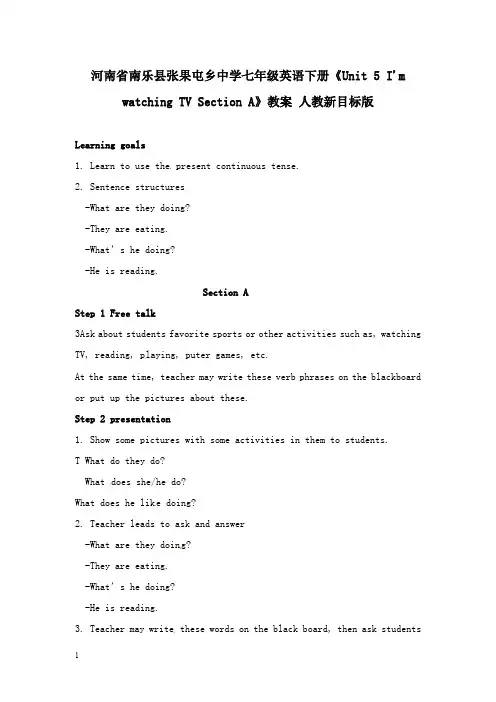
河南省南乐县张果屯乡中学七年级英语下册《Unit 5 I'm watching TV Section A》教案人教新目标版Learning goals1.Learn to use the present continuous tense.2.Sentence structures-What are they doing?-They are eating.-What’s he doing?-He is reading.Section AStep 1 Free talk3Ask about students favorite sports or other activities such as, watching TV, reading, playing, puter games, etc.At the same time, teacher may write these verb phrases on the blackboard or put up the pictures about these.Step 2 presentation1.Show some pictures with some activities in them to students.T What do they do?What does she/he do?What does he like doing?2.Teacher leads to ask and answer-What are they doin g?-They are eating.-What’s he doing?-He is reading.3.Teacher may write these words on the black board, then ask studentsto add -ing to the words.Show1)play-playing watch-watchingclean-cleaning read-readingtalk-talking do-doing2) have-having write-writing3)stop-stopping swim-swimmingStep 3 PracticeTeacher shows another group of verbsLie-lying tie-tying die-dyingStep 4 TaskGuessing gameAsk four students to sit in the front of the class.Try not to let others find wha t he or she is doing.This gam e may operated by the teacher. It’s also played by students themselves if possible.Step 5 Consolidation.A sk students to finish the guessing game one by one. Try to make more chances to pr actice speaking English for students.Have a listening practice.Step 6 Homework1.Finish self-check 1.2.2.Write more than ten sentences according to the pictures of 2c on Page26.3.Make a surveyAfter school, please ring up your families or friends. See what they are doing at that moment.。
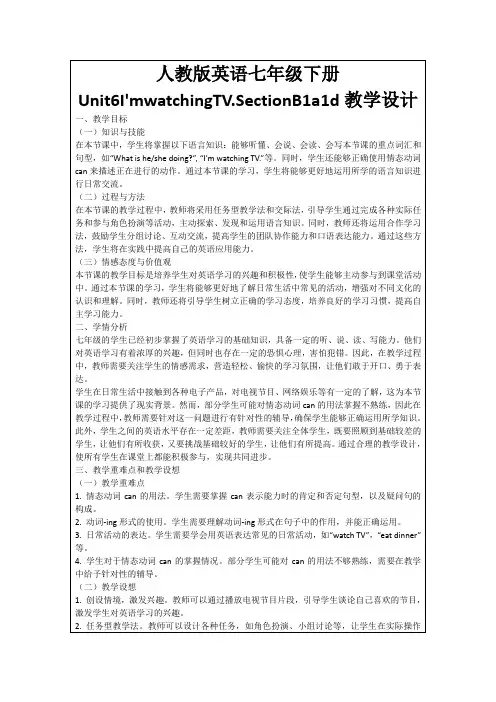
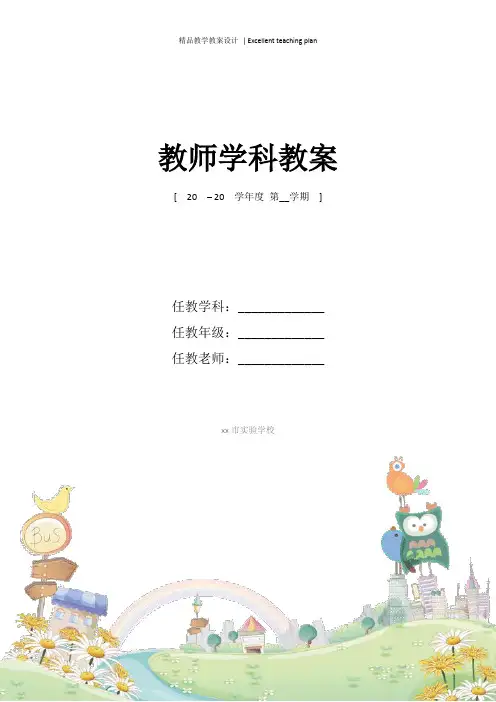
教师学科教案[ 20 – 20 学年度第__学期]任教学科:_____________任教年级:_____________任教老师:_____________xx市实验学校Unit6 I'm watching TV 教学设计一、教材分析本节课内容设计是围绕“everyday activities”这一个话题“谈论现在正在进行或发生的动作”,主要的教学内容是现在进行时,以“What are you doing?”这一主题引出现在进行时的一般疑问句,否定句以及特殊疑问句等语言功能。
这一话题贴近学生的日常生活,语言素材源于学生生活实际,因此有助于提高学生学习英语的兴趣。
我的教学设计理念:1、遵循任务型教学的教学理念,以学生为主体,以任务为中心,在运用语言完成任务的过程中来学习,体会和掌握语言。
2、自始至终贯穿了以交际为目的的原则(在做中学,在学中用)。
3、在教学过程中,关注学生的生活实际和生活体验,树立以学生为本的思想,提倡学生参与、体验、亲身实践、独立思考、合作探究,从而实现教学方式和学习方式。
二、教学目标1.知识目标1)短语和单词doing homework, watching TV, cleaning, eating dinner, read ing a book, talking on the phone, apartment2)句型结构What are you doing? I'm watching TV.What's he/she doing? He/She's reading.What are they doing ? They're watching TV.---Is he reading? ------Yes, he is./ No, he isn’t.3)语法The structure of the Present Progressive Tense The present participle2.能力目标1)能用现在进行时的各种形式进行准确的描述和表达正在发生的动作。
Unit 6 I’m watching TV. Section A 1 (1a-2d) 一、教学目标: 1. 语言知识目标: 1) 能掌握以下单词和短语: newspaper, use, soup, wash, movie, read the newspaper, use the computer, make soup, go to the movies 能掌握以下句型: ① —What are you doing? —I'm watching TV. ② —What's he doing? —He's using the computer. ③ —What are they doing? —They're listening to a CD. 2) 能掌握语法:现在进行时态的用法。 3) 能运用所学的知识,描述人们正在做的事情。 2. 情感态度价值观目标: 通过对本单元的学习活动,能培养培养学生学习英语的强烈兴趣,善于发现生活中正在发生的事情,积极思考,乐于助人,乐于参加各种活动的积极情感,培养学生团结合作的精神。 二、教学重难点 1. 教学重点: 1) 词汇、词组搭配和现在进行时的用法。能用现在进行时的各种形式进行准确的描述和表达正在发生的动作。 2) 能掌握现在进行时态及一些表示具体动作的词组搭配,如: doing homework, using the computer, watching TV, eating dinner… 等 2. 教学难点: 现在进行时句型结构的各种形式变化,能在交际中准确地运用现在进行时来描述或表达正在进行的动作。 三、教学过程 Ⅰ. Warming-up and Lead in 1. Greet the Ss and watch a video program. Ⅱ. Presentation 1. Show some pictures on the big screen. Present the new words and expressions. 2. Ss watch and learn the new words and expressions. 3. Give Ss some time and try to remember the new words and expressions. 4. (Show some pictures on the screen and ask some students to perform the actions.) e.g. T: What are you doing? S: I am doing homework. (Help him/her to answer) T: What is he /she doing? Ss: He /she is doing homework. Teach: watching TV, cleaning, reading a book, eating dinner, talking on the phone...as the same way. 5. Work on 1a. Ss read the activities and look at the pictures. Then match the activities with pictures. 6. Check the answers with the Ss. Ⅲ. Game (guess) 1. T: Now let's play a game. What's she/he doing? You must watch the big screen carefully. (Show some pictures on the big screen quickly) Let Ss guess what's he/she is doing? 2. Ss watch and guess the actions. 3. Ask and answer about the pictures. —What's he/she doing? —He's/She's … Ⅳ. Listening 1. T: What are Jenny, John, Dave and Mary doing? Now let’s listen to the tape, find out the right activities from 1a. 2. Play the recording for the Ss twice. 3. Ss listen to the recording and write the numbers from 1a. Ⅴ. Pair work 1. Ask the Ss to read the conversations in 1c with a partner. Then look at the pictures in 1a. And conversations about other person in the picture. 2. Ss make conversations by themselves and practice the conversations. Ⅵ. Listening 1. Work on 2a; T: Jack and Steve are talking on the phone. What are they doing now? Listen to the conversations and match the answers with the questions. (Play the recording for the first time, students only listen carefully. Then, listen to the recording again, and match the answers with the questions. ) Check the answers. 2. Work on 2b. Let Ss read the conversation in 2b first. Then play the recording for the Ss twice. The first time Ss only listen and write down the words in the blanks. Then play the recording again for the Ss to check the answers. (If necessary, press the Pause button to help.) Ⅶ. Pair work 1. Now, role-play the conversation with your partners. 2. Let some pairs to act out the conversation in front of the class. Ⅷ. Role-play 1. Ask Ss to read the conversation in 2d and answer the questions below. ① Are Jenny and Laura talking on the phone? (Yes, they are.) ② What's Laura doing now? (She's washing her clothes.) ③ What's Jenny doing? (She's watching TV.) ④ When do they meet at Jenny's home? (At half past six.) 2. Ss read the conversation and answer the questions above. 3. Check the answers with the Ss. 4. Let Ss work in pairs and role-play the conversation. Homework: 1. Review the words and expressions in this period. 2. Understand the knowledge about the present progressive tense. 3. Make five sentences on what are you doing now. 板书设计:
Section A1 (1a-2d) Drills: 1. —What are you doing? —I'm watching TV. 2. —What's he doing? —He's using the computer. 3. —What are they doing? —They're listening to a CD. 2b: are, doing; watching TV. listening to a CD, boring, interesting, go 2d. ① Are Jenny and Laura talking on the phone?(Yes, they are.) ② What's Laura doing now? (She's washing her clothes.) ③ What's Jenny doing? (She's watching TV.) ④ When do they meet at Jenny's home? (At half past six.)